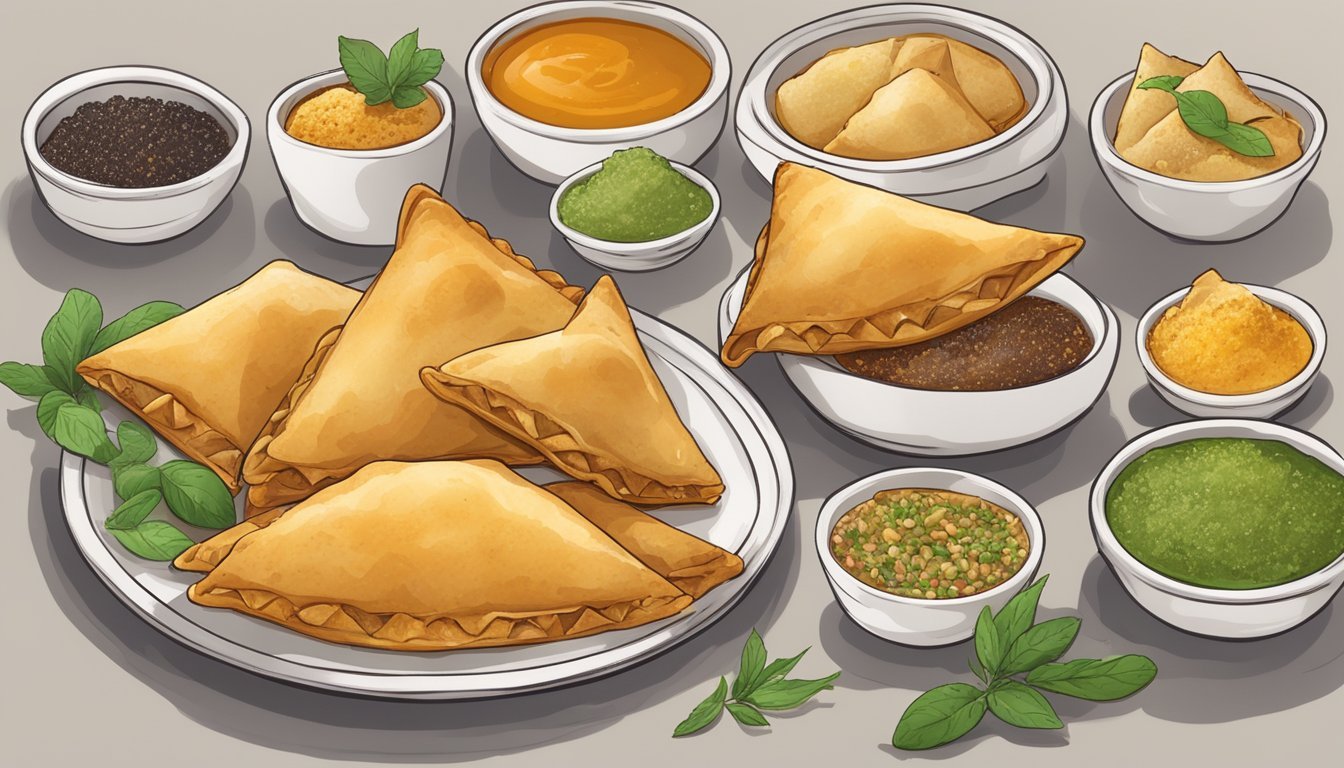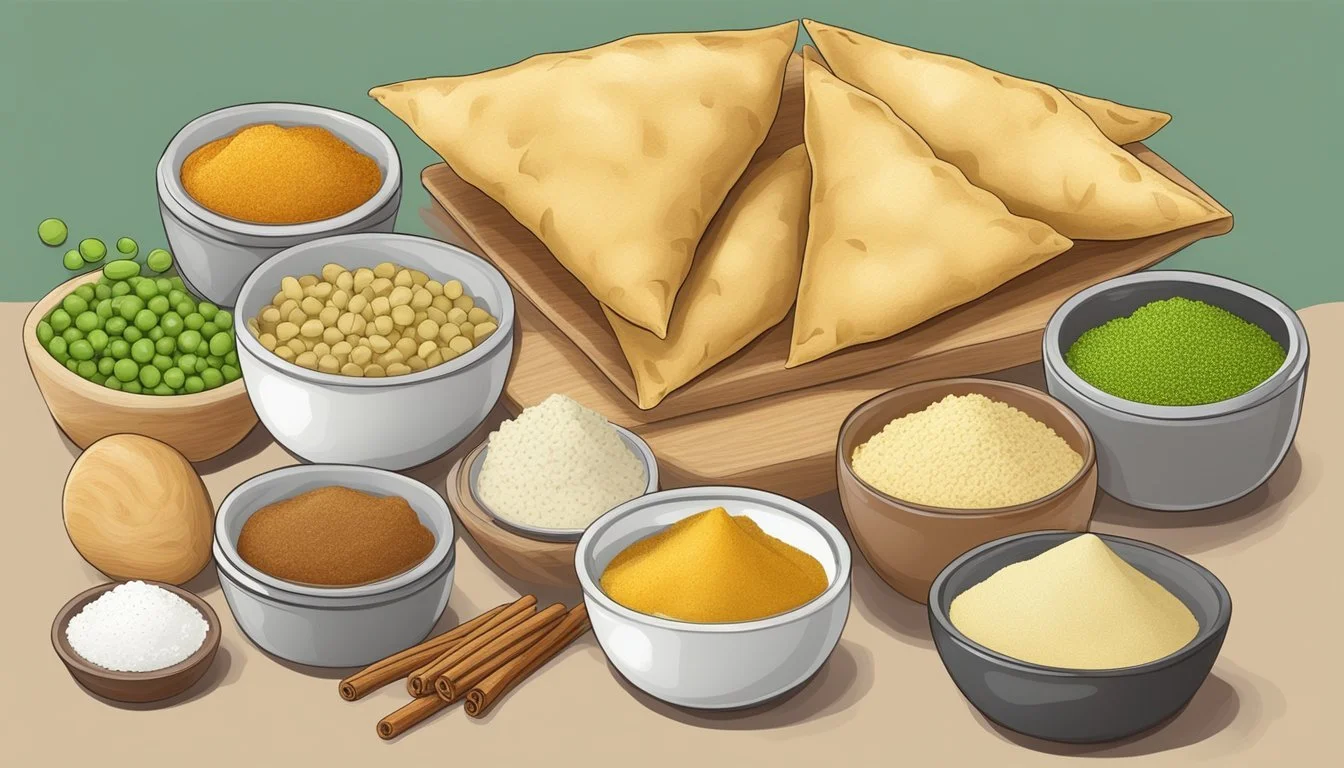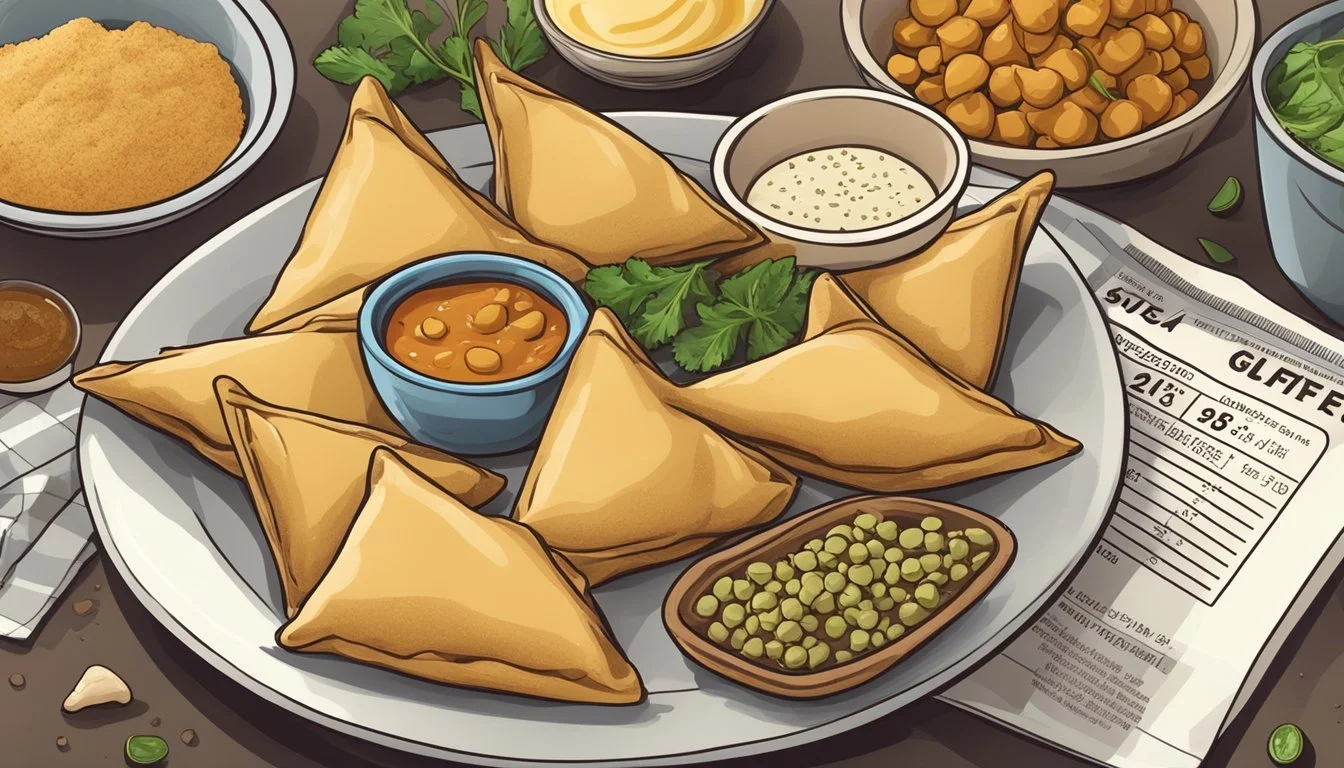Are Samosas Gluten-Free?
Unveiling the Facts About This Popular Snack
Samosas are a popular snack originating from South Asia, known for their crispy pastry exterior and flavorful filling, which commonly includes ingredients such as potatoes, peas, and spices. The traditional pastry shell is made from wheat flour, rendering the ubiquitous samosa unsuitable for those with gluten intolerance or celiac disease.
The question of whether samosas are gluten-free is a topic of interest for many who follow a gluten-free diet but still wish to enjoy this delectable dish. Fortunately, culinary adaptations have been made to make this snack accessible to those avoiding gluten. Gluten-free samosas employ alternative flours such as rice or chickpea flour to create a dough that is free from gluten while striving to maintain the characteristic texture and taste that samosa lovers expect.
Despite the adaptations, caution is advised for individuals with gluten sensitivities when purchasing samosas from stores or restaurants, as cross-contamination with gluten-containing ingredients can occur. However, homemade gluten-free samosas with carefully selected ingredients provide a safer option for gluten-sensitive individuals to relish this traditional snack without worry.
Understanding Gluten in Food
In this section, the focus is on the critical role gluten plays in traditional food items and how one can identify and select gluten-free alternatives, particularly when it comes to preparing or choosing gluten-free samosas.
Exploring the Role of Gluten
Gluten is a group of proteins found primarily in wheat, barley, and rye. It serves as a binding agent, giving elasticity to dough and allowing bread to rise during baking. In foods like traditional samosas, gluten is inherent in the wheat flour used to make the dough, which provides the characteristic chewy texture. However, for individuals with celiac disease or gluten sensitivity, consuming gluten can lead to adverse health effects, necessitating gluten-free alternatives.
Identifying Gluten-Free Foods
The process of identifying gluten-free foods begins with scrutinizing food labels and ingredient lists. Foods naturally gluten-free include fruits, vegetables, meat, poultry, fish, dairy, and most grains like rice and corn. Gluten-free cooking often involves substituting wheat flour with gluten-free flour such as rice, almond, or potato flour. To make gluten-free samosas, one must ensure that the dough is made with gluten-free flour. Additionally, cross-contamination with gluten-containing foods must be avoided during preparation. The following table lists common ingredients used to prepare gluten-free dough:
Gluten-Free Flour Binding Agent Additional Ingredients Rice flour Xanthan gum Salt Chickpea flour Psyllium husk powder Water Sorghum flour Flaxseed meal Oil
Gluten-free alternatives require specific combinations to mimic the texture and cohesiveness provided by gluten in traditional baking. Maintaining a strict separation of cooking tools and surfaces is also critical in gluten-free cooking to prevent cross-contamination.
The Basics of Samosas
Samosas are a quintessential Indian snack known for their distinctive triangular shape and savory filling. This section delves into the fundamental components that define a samosa and underscores its cultural significance.
Traditional Samosa Ingredients
A samosa traditionally consists of a pastry shell made from all-purpose flour, which constitutes the primary gluten-containing ingredient. The pastry encapsulates a rich filling, commonly a mixture of:
Potatoes (diced and boiled)
Green peas
Spices such as:
Cumin seeds
Garam masala
Turmeric
Salt
The filling might also include other vegetables, lentils, or even meats like ground lamb or chicken. The preparation of samosas involves stuffing the pastry with the filling, then folding it into a triangular shape before frying it to achieve a crispy and golden exterior.
Cultural Importance of Samosas
Samosas enjoy a special place in Indian cuisine and are an integral part of various festivities and gatherings. They are commonly served as an appetizer or a snack and are relished across different regions of India with local variations in the filling and spices. The presence of samosas at important events underscores their cultural significance and the role they play in bringing people together over shared culinary experiences. The spice levels and fillings are often tailored to regional tastes, making samosas a diverse and adaptable component of Indian food (What wine goes well with Indian food?) culture.
Gluten-Free Samosa Ingredients
Crafting gluten-free samosas requires careful selection of non-gluten flours and preparation of fillings that adhere to gluten-free guidelines, while not compromising on the traditional flavors and textures.
Choosing the Right Flours
For the pastry, key gluten-free flours include almond flour, tapioca flour, and rice flour. Almond flour adds a rich, nutty flavor and helps with browning, while tapioca flour gives the dough elasticity and rice flour offers a light and airy texture. They can be combined in specific ratios to mimic the consistency of traditional samosa pastry dough.
Spices and Seasonings
Samosas are known for their aromatic spices. Essential seasonings include cumin, which should be used liberally for its warm and earthy flavor, and salt, which enhances the overall flavor profile. These spices blend well with gluten-free ingredients, maintaining the samosa's signature taste.
Gluten-Free Fillings
A classic filling combination for gluten-free samosas might consist of peas, potatoes, and onion, often with the inclusion of carrot for additional sweetness and texture. It's important to ensure the filling is well-cooked and seasoned to complement the gluten-free pastry.
Potatoes: Diced and boiled until just tender.
Carrots & Peas: Finely chopped and sautéed with onions until fragrant.
All vegetables should be mixed and allowed to cool before stuffing into the pastry.
Making Gluten-Free Samosas
Crafting gluten-free samosas involves adjusting traditional recipes to accommodate gluten-free dietary requirements while maintaining the classic textures and flavors. It's essential to carefully select substitutes for standard wheat flour that will yield a crisp, yet tender, dough.
Preparing the Dough
To create the gluten-free dough, one must substitute traditional wheat flour with a blend that may include gluten-free flours like rice or chickpea flour. A critical ingredient to ensure elasticity and binding in the absence of gluten is xanthan gum, which needs to be added along with gluten-free baking powder to help the dough rise.
Basic Gluten-Free Samosa Dough Recipe:
2 cups gluten-free flour blend
1 tsp gluten-free baking powder
1/2 tsp xanthan gum (if not included in the flour blend)
1/4 tsp salt
3 tbsp oil
Approx. 3/4 cup water (added gradually)
One combines dry ingredients first, followed by the oil. Water should be added little by little to form a firm dough. After mixing, the dough should rest, covered, to ensure hydration throughout.
Shaping and Filling the Samosas
Once rested, the dough is divided into small portions and rolled out into thin oval shapes. The samosa filling typically consists of a savory mixture, which can include spiced potatoes, peas, or lentils.
Steps for Shaping and Filling:
Cut the rolled dough in half to create two semi-circles.
Spoon the filling into the center of each semi-circle.
Moisten the edges with water to help seal and fold the dough over the filling, creating a triangular shape.
Care must be taken to ensure that the samosas are sealed well to prevent opening during cooking.
Cooking Methods
Gluten-free samosas can be cooked using various methods, such as frying or baking. For frying, one heats oil in a pan and cooks the samosas until they're golden and crispy, which typically takes about 8-10 minutes. When frying samosas, use a slotted spoon to transfer them onto a platter with paper towels to drain excess oil.
Frying Method:
Heat oil in a deep pan.
Fry samosas in batches, being careful not to overcrowd the pan.
Cook until golden, then transfer to a paper towel-lined plate.
Alternatively, for a lighter version, one may choose to bake the samosas. Preheat the oven to 375°F (190°C), line a baking sheet with parchment paper, and brush the samosas with oil before baking until they're crisp and golden.
Baking Method:
Preheat oven to 375°F (190°C).
Place samosas on a parchment-lined baking sheet.
Bake until golden brown, approximately 20-30 minutes.
Each of these methods yields a satisfying gluten-free samosa, with the desired contrast of a crispy outer shell encompassing a flavorful, aromatic filling.
Gluten-Free Cooking Techniques
When making gluten-free samosas, one must approach frying and baking with precision to maintain a crispy texture without gluten. The safe preparation of gluten-free foods is also crucial to avoid contamination.
Frying and Baking Tips
Frying:
When frying gluten-free samosas, use a high-smoke-point oil such as canola or vegetable oil to achieve a crispy texture. Gluten-free dough often lacks the elasticity of gluten-containing dough, so it is important to:
Heat the oil to the right temperature (typically between 350°F to 375°F) before adding the samosas.
Turn the samosas every few minutes for even cooking. This should take about 8-10 minutes until they are golden and crispy.
Baking:
For those who prefer oven-baked samosas, preheating the oven to 375°F is a vital step. To ensure a crispy result:
Line a baking sheet with parchment paper.
Construct samosas with a gluten-free flour blend, incorporating cold water and fats like butter or olive oil carefully to form a flexible dough.
Bake until the pastries are golden brown, which may require adjusting the time based on their size and the oven's performance.
Keeping Gluten-Free Food Safe
Cross-Contamination Prevention:
Utensils, equipment, and cooking surfaces must be dedicated solely to gluten-free cooking.
Use distinct storage and labeling to keep gluten-free ingredients separated from gluten-containing items.
Ingredient Control:
Source ingredients that are certified gluten-free to ensure they have not been processed in a facility that handles gluten.
Clear communication with any suppliers or manufacturers about the need for gluten-free products is essential to avoid accidental contamination.
Careful consideration to these techniques will significantly enhance the safety and quality of gluten-free samosas.
Serving and Enjoying Gluten-Free Samosas
When serving gluten-free samosas, the focus lies on the perfect combination of texture and taste, enhanced by carefully chosen sauces and presentation styles that cater to both dietary needs and flavorful experiences.
Pairing with Sauces and Chutneys
Gluten-free samosas pair exceptionally well with a variety of sauces and chutneys, adding a layer of flavor that complements the savory filling. Tamarind chutney is a popular choice, known for its sweet and tangy profile, while coriander chutney introduces a fresh, herby dimension.
Tamarind Chutney: Offers a tangy sweetness, ideal for balancing the spices within the samosa.
Coriander Chutney: Brings a vibrant green color and a zesty kick, perfect for those who enjoy herbaceous notes.
Ginger Chutney: A spicy and warming option that pairs well with the potato-based filling of the samosas.
Always serve these sauces fresh and at a temperature that does not overpower the warmth of freshly-fried samosas.
Presentation and Accompaniments
Presenting gluten-free samosas involves more than just placing them on a plate; it's about creating an inviting experience. Serve them while they're warm, ensuring they retain the ideal texture—crispy on the outside, tender on the inside. The triangular shape of the samosas should be highlighted, often arranged in a circular pattern around the dips for visual appeal.
Dip Placement: Centralize the dipping sauce for easy access, allowing guests to effortlessly dip their samosas.
Garnishes: Add a touch of elegance with a garnish of fresh chopped coriander or a sprinkle of mild spices for color contrast.
Accompaniments like salads or a side of steamed vegetables could be added for a complete meal, keeping in mind the gluten-free theme throughout.
Dietary Considerations and Substitutions
When adapting samosas to meet various dietary needs, it’s essential to consider both the ingredients and preparation methods. Here's how samosas can fit into vegetarian, vegan, and other alternative diets by employing strategic substitutions.
Vegan and Vegetarian Options
Samosas traditionally feature a potato and pea filling, making them an excellent choice for vegetarians. To ensure they are suitable for vegans, cooks should opt for a dough made without ghee—the clarified butter commonly used—and check that no animal products are used in the filling.
For vegan dough, substitute ghee with:
For vegan fillings, avoid:
Paneer (cheese)
Ground meat
A common vegetarian filling consists of:
Potatoes
Green peas
Spices (e.g., garam masala, cumin)
Alternative Dietary Needs
People with gluten sensitivities or those following a paleo diet require specific modifications to traditional samosa recipes.
For gluten-free samosas, replace wheat flour with:
Gluten-free all-purpose flour
A mix of rice flour and almond flour for a nuttier taste (not suitable for nut-free diets)
Note: Always ensure that baking powder and any other additives are also gluten-free.
For a paleo-friendly version:
Avoid grains and legumes in the dough and filling.
Use alternatives like almond flour or coconut flour for the dough.
Fillings can be meat-based or solely composed of paleo-approved vegetables.
Nut-Free Consideration
When making gluten-free dough, confirm that the gluten-free flour mixes are free from nut-based flours if serving to someone with nut allergies.
Exploring Samosa Varieties
Samosas present a delightful array of regional recipes and creative fillings, each offering a unique taste experience. This variety extends from the traditional to the innovative, ensuring there's a samosa for every palate.
Regional Variations
Regional samosa recipes are as diverse as the cultures they come from. Commonly found in a triangle or cone shape, these pastries can be filled with a range of ingredients.
South Asia: Typically, they are stuffed with spiced potatoes, peas, meat, and seasoned with ground cumin and other spices.
Middle East: Variations might include meat with pine nuts or onion with sumac.
Africa: Samosas in this region might feature fish or meat with local spices.
Local spices often define these regional varieties, with cumin seeds being a prevalent ingredient across many recipes.
Creative Gluten-Free Fillings
Switching to gluten-free samosas doesn't mean sacrificing flavor. Here are some inventive fillings that are both delicious and free of gluten:
Spinach and Paneer: A classic pairing, with wilted spinach and cubes of soft paneer cheese.
Chicken Tikka (What wine goes well with chicken tikka?) : Tender pieces of chicken marinated in tikka spices.
Keema: Ground meat (such as lamb or beef) cooked with peas and aromatic spices.
Mixed Vegetables: Chopped carrots, beans, and russet potatoes bound with gluten-free spices.
Creative gluten-free samosas often substitute traditional wheat flour with alternatives such as rice flour or potato starch to cater to those with dietary restrictions.
Nutritional Information and Health Benefits
When assessing samosas for their nutritional content and potential health benefits, it is crucial to consider both their caloric value and macronutrient composition, as well as how the gluten-free variation stands in relation to health.
Calories and Macronutrients
Vegetable samosas, a popular snack originating from South Asia, are typically deep-fried and filled with a mixture of vegetables and spices. The calorie content of a standard vegetable samosa can vary, but on average, one samosa may contain approximately 100 to 200 calories. In terms of macronutrients, samosas generally provide a mix of carbohydrates from the dough and filling, protein from the vegetables or added paneer, and fats from the oil used in frying.
Calories: Approximately 100 to 200 per samosa
Carbohydrates: Dependant on the size of the samosa and the thickness of the dough
Protein: Varies based on the vegetable or additional protein sources used
Fats: Primarily from the oil used in frying or baking
Understanding the Health Aspect of Gluten-Free Samosas
When a samosa is made gluten-free, it excludes ingredients such as wheat flour that contain gluten. For individuals with celiac disease or gluten sensitivity, gluten-free samosas provide a safe alternative that mitigates the risk of adverse health effects associated with gluten ingestion. While being gluten-free does not intrinsically make a food healthier, it is a necessary dietary modification for those affected by gluten-related disorders. It's important to note the potential difference in macronutrient content due to alternative gluten-free flours used which could affect the overall caloric value.





